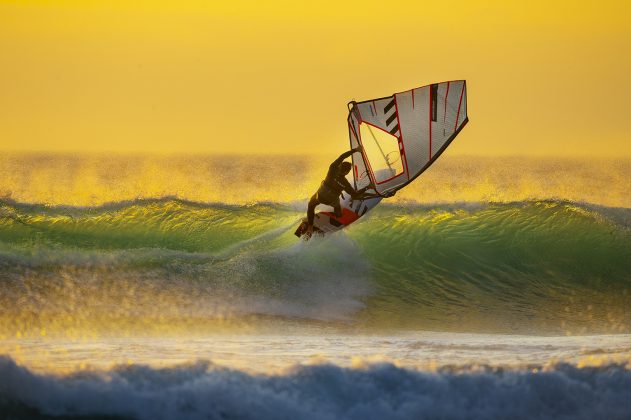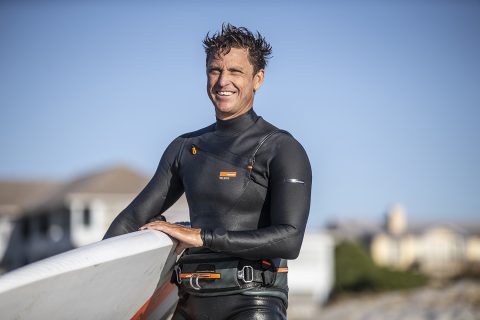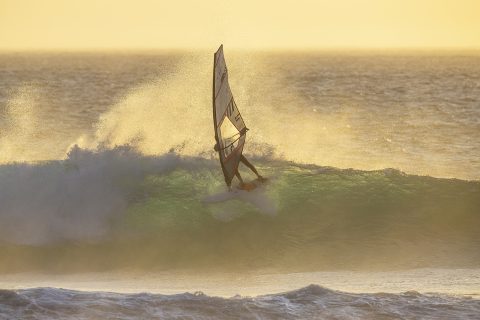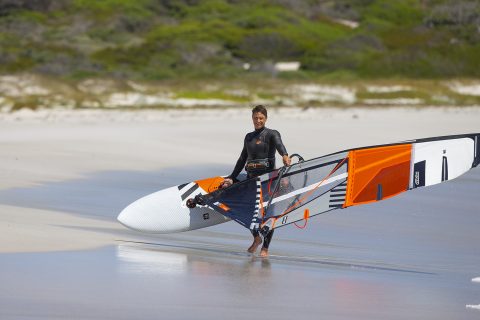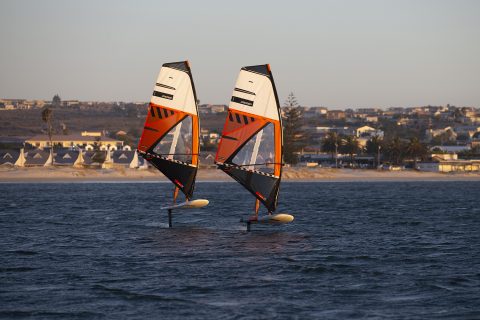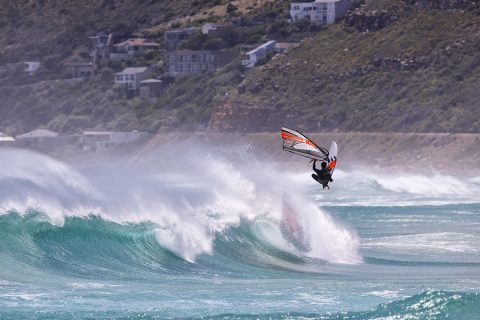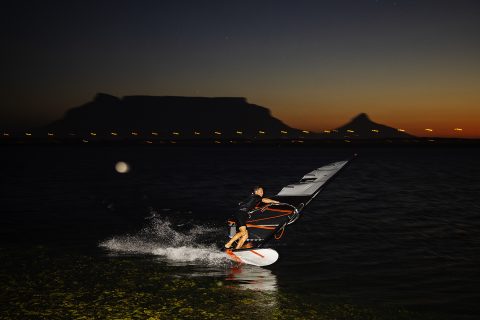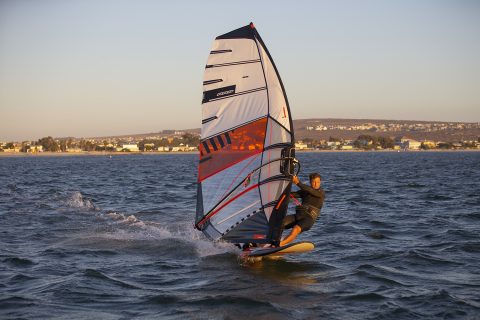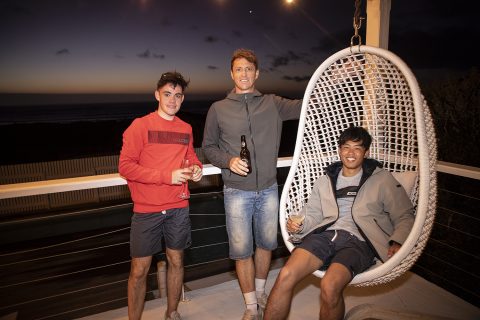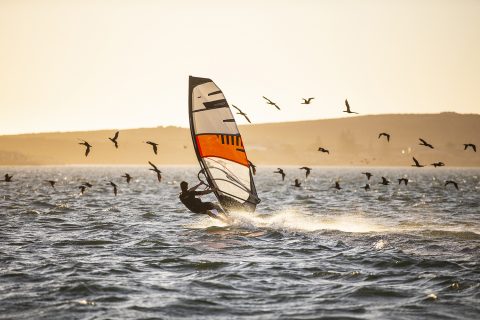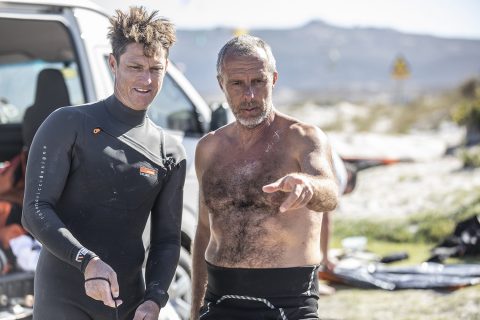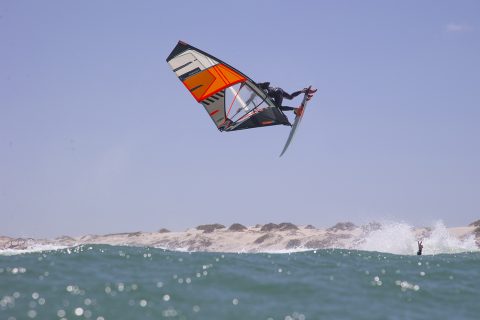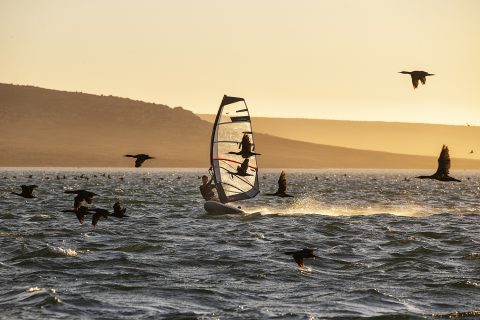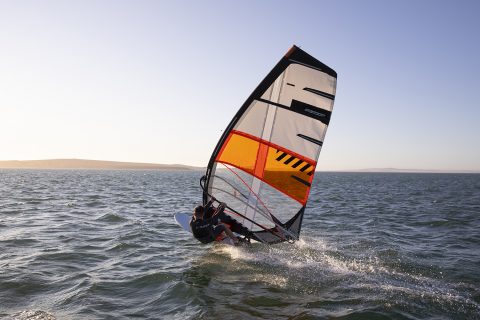We featured this profile on John Skye in our October 2020 issue of Windsurf Magazine:
From being at the top of his game as multiple British wave champion, as well as his incredible PWA performances, John Skye’s career has now evolved into the design side of the sport as RRD’s chief sail designer. Bringing to market the groundbreaking compact sail as well as working on innovations with moulded sails, John is carving out a reputation as someone not afraid to try new ideas. The ever-popular Brit, now based in Gran Canaria, gives us an insight into how he fits work around family life and his relationship with the boss, Roberto Ricci!
Photos John Carter
- Click to enlarge: John Skye at work in Cape Town
SAIL DESIGNER
My career as a team rider is definitely over, and I am now fully focussed on sail and product design at RRD. My work not only covers the design part of the process, which is for sure the most interesting, but also includes following through for the complete production cycle. This includes sourcing materials, communicating with multiple factories around the world, working on packaging, visiting factories, co-ordinating the graphics with our team in Italy, then obviously testing, development, working with the team riders and finally putting it all together into a complete product that arrives in the customers hands. Now 90% of the travelling I am doing is work related – China, Italy and Cape Town, with a few trips for promotional events on top. It’s good, but I really miss the fun trips, like going to Maui and don’t really do any cool surf adventure trips now. The great thing is that if I want to, I can still sail every day. I have tonnes of equipment to test all the time and we have a lot of windy days in Gran Canaria. In the past years I have probably sailed slightly more slalom than waves, but honestly I love the challenge of designing a race sail, plus sailing full power on slalom gear is pretty hardcore when the conditions are tough.
What I probably miss most is a little bit of variety in my sailing. Before with all the travelling and competing, it was always a mix of cultures, climates and best of all for me, conditions. Now in comparison it is much more fixed, and particularly in Gran Canaria we don’t get a huge range of different sailing. Coming to Cape Town every year to do the photo shoot is a really nice change and I get to sail a greater variety of conditions. Luckily, I am still needed in the shoot and this year I had some of the best sailing I had had in months. Especially when we were shooting waves it is nice to go out, have fun and push myself. We now have three kids on the team – Takara Ishi, Francesco Cappuzzo and Baptiste Cloarec, who are all really young and all competing against each other to get the best shots, and I was kind of drawn into the battle. I miss that little bit of drive I used to have when I was competing and my usual sessions now are just doing back loops all day long because they are kind of safe and relaxed. I am certainly not going to throw myself into a sixty-foot-high stalled double anymore! However, doing the shoot with these guys gave me a bit of a boost and the competitive side of me kicked in, wanting to show the kids I am not over the hill just yet!
- Ripping on the moulded sail
MOULDED SAIL
This year, before the Covid-19 situation hit, we were planning to introduce a fully moulded sail made in a completely new technology for windsurfing. We are working with a company from Florence in Italy, they have been developing the technology with yacht sails for a while. The whole sail is pretty much one piece, including the batten pockets, and for the most part the sail has no stitching. Only the border reinforcement, the monofilm window and details like the batten tensioners and tack pulley are stitched. The production is really high-tech and the sail is made under laboratory conditions. The various layers are cut first on a plotter, then the sail is laid up according to our precise specifications and finally put into a mould which heats it to 110 °C under around 9 tonnes/m2 of pressure to bond the layers and this is then held for over an hour. The temperature is carefully monitored with multiple points over the whole sail to control every stage of the curing. As a result, the sails are coming out really strong and between 10 and 20 % lighter.
The feeling on the water is incredible. They are super soft, with a very forgiving power. We tried it first of all for freestyle, but after testing it was clear it was much more suitable for wave sails, so we immediately started developing that idea. The plan is to introduce a moulded wave sail first and then depending on the market, think about introducing other sails later. So far, all the riders love it and they are holding up really well. I think this could be the future of high-performance sails. No other companies are using this technology. The standard membrane sail that other brands have are basically made up with separate panels like a conventional sail, and then stitched together like normal. The only benefit is that the reinforcement is built in, so they don’t need to add extra patches. Our new sail is just one piece, so that is where we really have the advantage. Obviously with the main production being in Florence, the whole project was hit really hard this spring, but hopefully we can get back on track quickly and bring it to market.
- The compact rig
COMPACT SERIES
I am really proud of the RRD Compact Series; I really think it has been one of the biggest revolutions in the last 10, if not 20 years! If I think back to when I first started windsurfing, I remember the first mast I ever bought was one of the early two-piece masts. Before that, all my dad’s masts were 1 piece! That felt like a huge breakthrough at the time. You didn’t need to carry a 4-metre-long pole on the roof with you anymore, suddenly you had half that length to deal with. The Compact Series is taking that to a whole other level. The really important thing that people need to understand is that the performance is amazing. I still think some potential customers perceive it to be a bit of a gimmick and only consider it useful if they were on a boat or somewhere where the rig really needed to be compact. For me, honestly I am happy to use these sails for all of my sailing. I have absolutely zero issues using a compact, no matter where I sail, and this year I think my only sails will be the Compacts. It is a really cool concept and I just want to keep showing everyone that the performance is the same as any other wave sail. It can do everything the same as a normal sail, and most of the time I even roll it up like a normal sail, but at the same time you have this convenience when you need it.
- Compact action
The basic concept is to choose three sails, for example a typical 5.3, 4.6 and 4.1 wave sail quiver, and then have one rig pack with 2 sizes of mast for each rig pack. So in the wave version this means having a 340 and a 400. The performance and flex characteristics of the compact 400 mast are the same as a standard 400 wave mast, so you have top performance for the larger sizes. Then when it is windy you take one section out of the bottom, which gives a nice soft 340 mast, which is perfect for the small sizes of sail. So there is no compromise either way. The same applies to the larger freeride sails, with a 430 mast for the larger sizes and a 370 for the smaller ones. The boom has been improved a lot this year. Previously we had a clip in the centre of the boom which sometimes got in the way a bit, but now the join is invisible, so again there are no compromises at all. The only small compromise with the whole system is a very slight weight increase in the mast weight, but this is not even noticeable on the water.
The whole concept has evolved loads since we started. The first year we were just getting the product to market. We are now in the third generation, with a new batten system, improved carry bag, better boom and more. We have ironed out all the weak points and I really believe it is a great product for a lot of situations. It is obviously great for people with campervans, boats and families with tonnes of stuff in their car, or guys with small apartments, plus for many it is just so nice to have everything you need in one small bag. Just throw it in the car and know you have everything.
- One handed air in South Africa
CHINA
Normally I do two trips a year to China to check production, check the quality of the sails and work directly with the guys out there. At first the trips were amazing as everything was new and exciting, but now the novelty has worn off a bit and they are pretty much just pure work trips now. They are important though as everything is so much easier when you are there. They can make quick modifications to a design and you can re-rig them later in the same day for instance. Also for certain things it is so much easier in the factory. For example a new sail bag, it is so easy to go through all the sample materials they have in their warehouse, get pricing for them on the spot, make a test version quickly, modify if necessary and get it right straight away in a day or 2. That would be much harder to do remotely and often costs a lot in shipping samples around the world. Another example is when we are making pre-production sails, quite often the graphic on the computer looks amazing, but when you see it for real it might not look so good and needs a few graphical tweaks. Again, when you are there it is so easy to get it modified quickly and get all the final touches perfect ready for production.
Keeping tabs on the quality is critical, and also meeting the guys you are working with on a day-to-day basis. It is so important to have a connection with these people and I am very lucky because the team in our sail factory are amazing to work with. They all speak English really well and most importantly they are all, or were, windsurfers, so they understand what they are building and most importantly why they are building it. The main contact I deal with the most is so into windsurfing at the moment. He is at the early stages really but unfortunately for him there is not so much wind where they are based in China, so progressing is difficult and slow. However, whenever I am there, he is always asking me a million questions about technique, gear setup etc. It’s really nice to see that passion, and I think in the end that passion carries through the whole factory!
Covid-19 has affected the factory’s schedules a lot, but the launch of our new gear this year was planned for later anyway, so overall it has not really changed things too much for me. We were very lucky this year that we had everything completely finished and under control way before the virus hit, even our photo shoot and dealer meeting were done. I do need to go back to China in the next month or two though, and honestly I am pretty worried. Not so much about catching anything over there, as I think it’s probably safer over there than here at the moment, but the situation is changing so quickly it’s hard to make plans and so easy to have them really messed up with changes to regulations or travel advice.
MOTIVATION
I really enjoyed the challenge of designing the Compact Series. Not only did I have to work on the performance, but also, I had to go a lot more into the engineering side, which had its own challenges. That side to me is really interesting. The race sail is especially motivating. The project is always moving forward and it’s a little bit easier to define what we are looking for and evaluate performance. A wave sail is more subjective, with everyone having their own personal preference. One rider might love a certain feeling and the other guy might want it different. My job within that is to make a nice compromise that covers everything. We have one wave sail to cover all conditions, so it has to cover onshore all the way to wave riding. The race sail development is much more objective and clean-cut in its direction. I also really enjoy working on the freestyle sail. It is pretty much the only sail that I cannot develop/test on my own as my freestyle skills are not up to it, so the challenge becomes taking the feedback from the team riders and converting that information into something that works for them. It is actually a very different challenge to designing the other sails!
- John Skye night session
CAD
I work with a specific windsurf sail CAD program, so making changes is relatively easy now and all the designs are stored on my computer. There was a lot of learning in the beginning though. I had done quite a bit of CAD at university with boat design, but that was over 20 years ago, and the technology has changed somewhat in that time! So firstly I had to brush up and update my skills, and then start to take things forward. When I first started sail design, I put a lot of time into learning all the computer programmes. The knowledge was very useful to understand how the sail goes from the computer to the factory and is then made. My goal now is to control better the more advanced 3D programs. They are not necessary so much for the sail design, but it would be nice to be able to work more on the accessories, like boom parts, cambers etc, and design everything myself. Something like a boom head is a pretty complex thing to do on the computer.
- Slalom action in South Africa
THE OPPOSITION
When I first started designing, I paid a lot of attention to the other brands and the trends that were happening. I would not say I have ever copied anything, but definitely used them as a reference. The best example I have is when we were making our first Move sail, which is supposed to be our powerful five-batten freestyle-wave/bump-and-jump sail. One of the early versions I tested I thought had way too much power. Before changing anything though I went to the TWS centre in Tenerife and tested it against a few other equivalent sails. I soon realized that actually our sail sat in the middle of the bunch in terms of power, so I knew our sail was good as it was, or could even be more powerful. If you are just on your own, then you might fall out of place to where the market is, so I like to try and jump on as much gear as I can.
I also like to check the opposition graphics to see the things I like and don’t like, both on and off the water. Sometimes things look great on the beach and disappear on the water, and vice versa. Using all the other sails as references helps me decide what looks good and what doesn´t. This year before we started working on our graphics, I went around all the local rental centres and comprehensively checked all the other brands, observing details and taking loads of pictures. I then sat down with the graphics team and we went through the shots, discussing pros and cons, and most importantly what we thought would apply well to our sails and fit with our corporate look. It’s not only windsurfing influences though, I look at everything for ideas. We even once took a concept for a graphic element from a design that was on a computer case!
- Hanging with the RRD young guns
GRAPHICS
The graphics of RRD products is really important to Roberto and he often has very strong views about the direction we go in terms of the look. I don’t always agree with his decisions and sometimes we will have big discussions about it. However, one thing I will have to say is that he has such a good eye and instinct for that sort of thing. Even sometimes if I strongly disagree, we end up going with his concept and he is nearly always right. Since I started with RRD the sail graphic has slowly evolved, and we put a lot of attention and effort into it. If you put all the sails together from old to new, you will see a really nice graphical evolution, keeping the same design DNA through the line. I love how the changes are often small, but visually they are a big jump forward. A lot of this comes from our excellent in-house design team in Italy.
- Full power in Cape Town
The current graphic we have is a really good example of Roberto’s creative instinct and how he is flexible and not afraid to change his mind. Two years ago, when I started working on the 2019 sail graphics, Roberto wanted everything orange, pure solid orange, so we had a pure orange colourway that everyone agreed looked amazing. Then on his first freeride foil board he put some different coloured stripes across the deck so people would know where to put their feet when foiling without straps. He really liked this look and asked me to make a sail with the same concept. It was really late in the development process and I told him it was not possible in the time frame, but we pushed it through anyway and it came out great. The orange colourway was supposed to be the main line that year, but as soon as we saw the striped sails on the water, it was really clear the stripes were the one, so we made a sharp turn and went full power into the striped colour scheme. It has now become our company look across all the products. When we are at the dealer meeting with all the different gear on the beach, all matching, it just looked stunning. Now on the water it is really clear which sail or kite or board is an RRD. That is a great example of Roberto’s influence.
- John Skye at work with Roberto Ricci
FAMILY AND WORK
When I first started working for RRD I was working from home. Then when our kids came along, I found it was really hard to be productive. There was too much going on in our house, plus I found myself working ridiculous hours. In my position there is nearly always something that needs to be done. When you are at home and the computer is there, you get drawn into never switching off from work. I was working all the time, but at the same time not really so productive with all the distractions and lack of continuation. One of the best things I have done was to get a proper office about half a mile down the road. Once I had that I started to go to work and come home from work, which was great. When I am at work, I am really productive without distractions. I can rig sails or measure masts or whatever in the office. Then I finish work at around 5 or 6, I come home, switch off and have some proper family time. It is a much nicer balance. Most days, once everyone has gone to bed, I will go back to the computer and work a bit more in the late evening from home. As China is 8 hours ahead of us, working late at night is often more productive.
HAPPY PLACE
Right now, I am really happy. I have two wonderful kids, who are at a great age, and I love my work. I have a lot on my plate and put in a lot of hours, but I am totally free to put in those hours when I want or from where I want. That for me is gold. After being a pro sailor for fifteen years you get used to the freedom to do whatever you want, whenever you want and to switch suddenly to a fixed 9-5 would be killer for me. Last year Nayra was working 9 to 2 for a while and I saw how restricted she was, even with those hours. I can pop off for a quick sail or surf anytime I want and make up the hours later. I am not sure I could really cope with fixed working hours!
For me to be still working within windsurfing is just amazing, and if I think back to day-dreaming as a kid what I would do for a job, I could never have imagined this. Maybe the only slight negative is that I find it hard to switch off from windsurfing as a job. I love it, but whenever I am on the water I am always thinking about the product, whether it’s the sail or the boom or the mast or whatever, and it’s quite hard to just go sailing and enjoy it simply as pleasure. That is why I value those rare classic days so much more now, as they seem to be the moments I forget about everything and just enjoy the sailing.
- Mixing it up with the young guns in Cape Town
WINDSURFING PASSION
I love the variety in windsurfing, and most of all I just love the feeling of planing. It sounds really stupid, but it was that feeling of planing that got me hooked in the first place and I still love just flying over the water, no matter what the conditions are or the equipment I am riding. A slalom board right on the edge in high winds is just amazing and now you can even get that feeling with foiling in the lightest of winds. When I think back to my time learning on Brogborough Lake, to have had a foil back then would have been life changing! Obviously wave sailing is also amazing, both jumping and riding, and is still my main passion, but the variety of windsurfing is what I love the most. Blasting speed runs at 35+ knots, jumping fifty feet in the air or even foiling in 8 knots, they all have their own place and are great feelings.
- Sunset session
GRAN CANARIA
I grew up in Hertfordshire sailing on Brogborough Lake, which was a lovely childhood, but I always knew that I didn’t want to settle there. When I started doing trips, I always had one eye on every location as a place I might like to live. I spent a year in Fuerteventura after finishing university and I really liked that, but it was just a bit too slow for me. It’s a lovely place to go on holiday, but when you live there, and are used to somewhere on the outskirts of London, it was a bit too chilled for me. Australia was really nice, and there were quite a few of the UK south coast crew over there when I went. I really loved Maui and Swifty and a few other guys from university all ended up over there, so that was another place on the list.
Then I met Nayra and started spending more time in Gran Canaria. The conditions were not quite as good as Fuerteventura, but it was really consistently windy, and actually the lifestyle is great in Gran Canaria. It is a fully functioning place and a lot more practical to live in than Fuerteventura. I can sail pretty much every day of the year if I want and it’s very, very, good for testing. It is quite possible to test a 7.5m sail and 3.7m sail on the same day, getting lighter or stronger winds by moving up or down the coast. There are not many places where you can do that year-round, so from a work perspective it is perfect. We also have great surfing right in front of my house, which is a great way for me to disconnect and I think it’s a great place for the kids to grow up too. It’s also a short and inexpensive flight home to the UK, which is really nice to have, even if I don’t go back so much now.
- Flying in South Africa
FUTURE
For now I am just keeping doing what I am doing. I am in a happy place at the moment. My family is happy, and I love working for RRD and Roberto. He is a great boss and gives me the freedom to do what I want, and he trusts me to do that. We normally have two or three meetings a year where we sit down and discuss our objectives, then he mostly lets me get on with achieving those targets. That is a great feeling. I don’t feel like I have a boss breathing down my neck, but I know that he is watching what I am doing. On the whole it is a great relationship. Beyond that, from my experience in life you never know what is around the corner. Just look at what is going on with Covid-19 and we have no idea of the consequences in the short, medium or long term. Whatever happens, my ethic is to keep doing my best at whatever I am doing. Keep my eyes open and evolve to whatever is needed.


